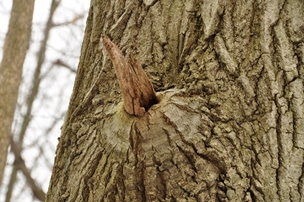Why we cut to the collar

enlarge this imageThe branch bark collar did an excellent job of growing over this pruning wound, but it can't close it completely while that stub is there. Determined pests have a toehold for their attack on the rich cambium below the bark.
The branch bark collar can't cover a stub
New tissues form at the branch bark collar, that place where the
branch's and trunk's cambiums meet -- the thin layer under the bark
which can produce new wood and bark.
Whenever you prune, cut to leave the collar in place, unharmed.
Make sure there's no stub or other impediment to this growth that
can close the hole with successive rings of new "wound wood."
Below, left: That stub which remains from an earlier pruning
prevents the woundwood from capping the opening.
Below, right: Seen from the side it's clear that the woundwood
can build up to a certain extent to cover a protruding stub, but
there are limits!


For more about proper pruning cuts and how a tree heals, check
What's
Coming Up #26 and What's Coming Up #112.
Below: In What's
Coming Up #26 is the full story of the proper pruning cut and
how a tree can close over even a large wound if the branch bark
collar is left in place.






